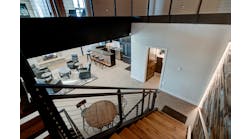More than 100 years ago, the St. Louis Public Library’s Central Branch celebrated its grand opening. On the eve of its centennial, a construction team faced a significant challenge — to not only modernize the building but also preserve its historic integrity. Through a $70-million project, the construction team renovated, restored, and revitalized the library by resurrecting its historic grandeur and reworking the library’s functions, says Steve Andert, manager, Electrical Engineering and Lighting Services and senior vice president for William Tao & Associates, the project’s electrical engineer and designer.
“The directors wanted the building to meet the informational and technological needs of its patrons well into the next 100 years, and they recognized the lighting and power systems as essential elements in accomplishing this goal,” he says. “Taking a building from an era when incandescent lamps were still a new technology to today’s plugged-in and powered-up society was a wonderful challenge.”
During the project, the design and installation of the new electrical systems had to complement the building’s aesthetics and functionality, says Andert. When William Tao & Associates first started designing the project, the building was fully occupied and functional. The HVAC, fluorescent lighting, and security systems, however, had maxed out its 120/208V electrical services. Additionally, portions of the ornamental plaster ceilings had been replaced with fluorescent strips and egg crate louvers, according to Andert.
“The lighting systems had weathered a century of wear and tear, obsolescence, theft, or loss, and several of the original fixtures were missing or damaged by vandalism or over-lamping,” says Andert. “The good news was that significant portions of the building’s historical features were still intact.”
Through careful historical preservation measures, the project team — including BSI Constructors, the general contractor; Sachs Electric, the prime electrical contractor; William Tao & Associates; and Cannon Design, the architect — brought the 185,000-sq-ft building into the 21st century. William Tao & Associates provided electrical and architectural lighting design services while Sachs Electric installed new
lighting, electrical and power systems, as well as a voice/data and fire alarm system with wireless access points.
“To meet the goals of the library in serving the public, the decision was made during the design phase to install a completely new electrical system to service the next 100 years,” says Joe Kaiser, executive vice president for BSI Constructors. “It is really exciting, when you look at the transformation — that we were able to not only preserve the 100-year-old architectural features of the building but also incorporate 21st century technology.”
Discovering pathways for wiring
The construction team managed to wrap up the project two months early, which was no easy feat. On the renovation project, the electricians faced two key challenges — they had no original electrical drawings to work from, and they only had a limited number of existing raceways. To discover continuous pathways, the electricians used digital inspection cameras along with traditional fishing techniques behind the century-old marble and granite walls.
“It was like performing minimally invasive surgery blindfolded,” says Joe Barnard, vice president of the St. Louis and Illinois regions for Sachs Electric. “We couldn’t see inside the walls, and we were never sure what obstructions we would encounter behind them. It took a lot of field investigation, trial and error, and sometimes a little luck.”
For example, the electrical team followed a pipe or conduit to its end point to figure out how to route the wiring. When they couldn’t find a straight path from point A to point B, they used convoluted pathways to avoid removing the marble or millwork or cutting channels in the original plaster walls. In some cases, the electricians had to route the wiring from the first floor to the third floor and then back to the second floor.
Kaiser says the routing of the new wiring demanded careful planning on the part of Sachs Electric.
“It was a very difficult process to do it in respect to preserving the architectural integrity of the 100-yr-old building,” says Kaiser. “It was very meticulous, and Sachs did a great job of handling a lot of challenging existing conditions.”
To preserve the building’s historic and ornamental finishes, the design and construction team tried to minimize the need to cut or patch the walls. They also incorporated field mockups and test procedures into the construction plans, met regularly with the owner, made a 3D photographic record of every space prior to construction, and protected surfaces with plywood enclosures, says Andert.
Constructing a building within a building
During the renovation, the team not only preserved the historic iconic landmark, but also created an entirely new steel structure inside of the existing library.
Prior to the renovation project, the library featured a seven-story, free-standing antiquated book stack system with glass floors to allow daylight penetration, Andert says. Because these stacks posed fire and earthquake safety issues, the team removed them to make way for a new multi-story atrium and north entrance. They also built a new reading and resource rooms, a café, a public space equipped with computers, and a spot for mobile shelving and book storage.
To construct this space, the workers used a crane to insert 650 steel beams and columns through 6-ft-wide windows. They then erected them more than 100 ft high inside of the library.
“It was like building a ship in a bottle,” explains Kaiser.
Because that portion of the job was new construction, and the rest of the job was a renovation project, the Sachs Electric team treated it like a separate project. In fact, the electrical contracting company assigned a completely separate team to work on this area.
“We didn’t have the same issues that we had in the existing structure,” Barnard says. “It was more like traditional new construction with new walls and new floors.”
Modernizing the electrical and lighting system
Because the library was designed to meet visitors’ current and future power and technology needs, Sachs installed a new 250kW emergency generator, constructed a new underground vault, and created an extensive underfloor duct system.
After installing a new 2,000A, 480/277V, 3-phase, 4-wire service, Sachs tied in the vault with the local electric utility’s underground district service loop. To maintain historical site aesthetics, the workers concealed the utilities underground.
The electricians also installed new energy-efficient lighting to illuminate the interior and exterior of the library. After developing comprehensive mockups and testing, the designer used a combination of LED, compact fluorescent, and induction lighting to meet the project’s visual, economic, and maintenance needs, says Andert. For example, the electricians installed LED lighting to illuminate the building’s façade, handrail, entry hall mural ceiling, and free-standing book shelves. With the help of St. Louis Antique Lighting Co., Sachs Electric also retrofitted some of the original lighting fixtures with modern lighting technology. Before they were removed from the site, the team cataloged, numbered, and photographed each fixture.
Sachs Electric retrofitted the uplights and original alabaster floor lamps with LED lamps. The existing historic bronze and alabaster lighting fixtures were also repaired, rewired, restored, and refinished. In many cases, these fixtures were fitted with a new light source, optics, and control capabilities to enhance the functionality and aesthetics of the space. says Andert.
According to Andert, the Cass Glibert building, which originally inspired him to pursue a career in architectural engineering, is nationally recognized as having some of the finest architectural spaces in the nation. He says he was pleased that the project was so well received by the owner, the community, and the industry.
“We were literally changing the face of history,” he says. “The juxtaposition of the new to the old feels like a fitting expression of an institution dedicated to preserving the culture and knowledge of past generations while inspiring new and future generations.”
Fischbach is a freelance writer based in Overland Park, Kansas. She can be reached at [email protected].
For more images and details about the project, visit our photo gallery.
SIDEBAR 1: By the Numbers
Sachs Electric, which had 30 electricians on-site during the peak of the project, installed the following items in the newly renovated library:
• More than 3,000 new or restored lighting fixtures
• More than 1,500 ft of LED lighting on the exterior of the building to highlight the library’s unique architecture.
• More than 500,000 ft of power wire
• More than 100,000 ft of conduit
• More than 2,500 ft of multi-cell cellular raceway in the floors.
Source: Sachs Electric
SIDEBAR 2: Project at a Glance
The historic Cass Gilbert Building, which houses the Central Branch of the St. Louis Library, included a gut rehab of the electrical systems, an updated children’s area, a new teen area, a new Creative Experience multimedia studio, a Center for the Reader, and wireless access throughout the facility. Here are some fast facts about the electrical design and installation.
• The electricians replaced and expanded the electrical distribution system to meet increased HVAC and technology loads.
• All the electrical pathways were seamlessly integrated in existing and new architectural spaces to maintain historic architectural finishes.
• The vertical risers were located in existing architectural voids and historic ventilation shafts to minimize cutting and patching.
• The building is fully wired to support 21st century technology at every table or seating area. The electricians cut holes in the existing concrete floors to provide power to all the tables, even those located in the middle of a room.
• Multi-cell cellular raceways were installed in existing reading room cork floors to serve power and data services. These raceways were coordinated with the 100-yr-old clay tile structural system.
• The electrical devices installed in the existing granite floors were custom designed for true flush mounting and installation conditions.
• The electrical systems were seamlessly integrated in the historic and new casework to support electrical lighting.
• The building-wide custom lighting controls included architectural dimming and motorized shading controls.
• The fire alarm systems included concealed annunciation devices, beam detection, and aspirating smoke detection systems to maximize coverage and minimize visual impact.
• Electrical device layouts were designed to accommodate the needs of multifunction spaces and flexible furniture arrangements.
• Special event power was provided in the great hall for performances.
• Electricians reused the existing abandoned raceways and outlet boxes to support custom lighting fixtures.
• The old boiler room was transformed into a 250-seat theater.
Source: William Tao & Associates





